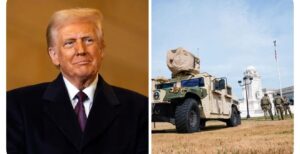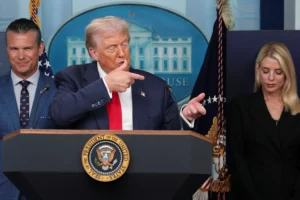

President Trump, with Defense Secretary Pete Hegseth and Attorney General Pam Bondi, speaks at a press conference yesterday. Photo: Jonathan Ernst/Reuters
When President Trump announced a federal takeover of D.C. law enforcement yesterday, he figured it’d draw muted opposition from the city’s mayor — and was likely to garner support among many residents, Axios’ Marc Caputo and Alex Thompson write.
Why it matters: Trump’s move marked an unprecedented peacetime expansion of presidential control of the capital city.
The announcement was widely condemned by national Democrats as an authoritarian overreach — and a prelude to takeovers of other cities in blue states.
Trump advisers say there are no concrete plans to replicate it elsewhere.
Zoom in: Trump has long criticized D.C.’s management and sought more federal control of the city during the Black Lives Matter protests in 2020.
He showed yesterday that his desire to score political points in the Democrat-run city — and dramatically exaggerate its problems — is very much alive.
White House insiders said Trump’s move was also prompted by his anger at seeing pictures of a wounded Edward Coristine, a former DOGE staffer known as “Big Balls” who was beaten and bloodied last week on a D.C. street.
D.C. Mayor Muriel Bowser called Trump’s move “unprecedented” and “unsettling” in a city where crime rates actually are declining. But her response was far more muted than many of her fellow Democrats.
It doesn’t matter if crime has gone down if you were a victim,” Bowser said at a news conference where she said she opposed the federal takeover but couldn’t do much to stop it because of the unique nature of how the federal city is governed.
Between the lines: Bowser has developed what both sides describe as a good working relationship with Trump, in part by avoiding the type of verbal spats with him that have ensnared other leaders in her party.
While other Democrats warned of peril in federal officers enforcing laws on D.C. streets, Bowser said she saw a potential upside: “The fact that we have more law enforcement and presence in neighborhoods, that may be positive.”
A backdrop to all of this: Bowser is seeking to maintain Trump’s support for a massive redevelopment project on federal land that would include a new stadium for the Washington Commanders and thousands of residences, plus retail and green space.

D.C. Mayor Muriel Bowser speaks at a press conference yesterday. Photo: Julia Demaree Nikhinson/AP
️ The big picture: Trump’s team was mindful of stats indicating that crime in D.C. has fallen significantly from COVID-era highs (charted above).
But they said many residents still don’t feel safe — a claim backed by a Washington Post/Schar School poll in May in which half of those surveyed in the capital said crime was either an “extremely serious” or “very serious” problem.
Big-city crime and immigration are core targets of Trumpism and, advisers say, the president believes that perceptions about public safety can outweigh statistics about declining crime.
2. GPT-5’s bumpy launch
Illustration of a cracked screen with a scrambled ChatGPT interface.
Illustration: Sarah Grillo/Axios
OpenAI’s GPT-5 has landed with a thud despite strong benchmark scores and praise from early testers, Axios AI+ author Ina Fried writes.
Why it matters: A lot rides on every launch of a major new large language model, since training these programs is a massive endeavor that can require months or years and billions of dollars.
The big picture: When OpenAI released GPT-5 last week, CEO Sam Altman promised the new model would give even free users of ChatGPT access to the equivalent of Ph.D.-level intelligence.
But users quickly complained that the new model was struggling with basic tasks and lamented that they couldn’t just stick with older models. They posted examples of GPT-5 making simple mistakes in math and geography.
Altman went into damage-control mode, acknowledging some early glitches, restoring the availability of earlier models and promising to increase access to the higher-level “reasoning” mode that allows GPT-5 to produce its best results.
Zoom in: Several factors fueled the underwhelming reaction to GPT-5.
GPT-5 isn’t one model but a collection of models, including one that answers very quickly and others that use “reasoning” — additional computing time to answer the prompt better.
As Altman explained in a series of posts, early glitches in the model’s rollout meant some queries weren’t being properly routed to the reasoning model.
GPT-5 appears to shine brightest at coding, particularly at taking an idea and turning it into a website or app. That doesn’t generate examples tailor-made to go viral like videos and images.
President Trump built a reputation as a consummate capitalist, but his dealmaking mirrors that of command-style economies, Axios’ Courtenay Brown writes.
Why it matters: In the Trump 2.0 era, the White House routinely makes extraordinary interventions in the economy and corporate America.
The big picture: Big-money commitments from foreign nations and domestic companies to placate Trump will inject billions into the U.S., if the investments materialize as planned.
Economists fear that it will set a dangerous precedent: the government picking winners and losers based on how much private capital companies are willing to put on the line.
Zoom in: Nvidia and AMD’s deal with Trump to give the federal government a cut of Chinese sales in exchange for permission to export key chips demonstrates his firm imprint on corporate America and the world economy.
Intel CEO Lip-Bu Tan visited the White House yesterday in a bid to smooth over tensions with Trump, who said last week the executive “must resign, immediately.”
Europe, Japan and others have collectively committed more than $1 trillion in investments as Trump threatened to escalate global trade wars.
Last week, Trump said Apple would be exempt from future chip tariffs because of the company’s plans to invest $100 billion in the U.S. over the next five years.
P.S. Trump said he will nominate Heritage Foundation economist E.J. Antoni to lead the Bureau of Labor Statistics. Steve Bannon backed Antoni as a preferred MAGA candidate for the role.
The U.S. construction, agriculture/mining and accommodation/food services industries have the greatest shares of foreign-born noncitizen workers, Axios’ Alex Fitzpatrick and Kavya Beheraj write from census data.
Why it matters: President Trump earlier this summer acknowledged that his massive immigration crackdown is “taking very good, longtime workers away from” the farming and hotel industries, and promised changes.
By the numbers: Foreign-born noncitizens — including those who are legal residents or have work visas — make up 8.3% of the country’s civilian workforce age 16 and older.
Ford’s decision to invest $5 billion in a new family of electric vehicles might seem crazy at this point, given how much the political winds have shifted against EVs since President Trump took office.
But widen the lens, and Ford’s big bet is the only natural choice in the face of existential threats to its business, Axios Future of Mobility author Joann Muller writes.
The big picture: More and more mainstream car buyers can’t afford to buy a new Ford, which sells for an average of $56,000.
At the same time, Chinese carmakers have figured out how to make inexpensive, high-quality, digitally advanced EVs, and they’re quickly taking over the world.
Reality check: Building affordable EVs profitably is harder without consumer tax credits and other EV-friendly policies killed by the Trump administration.
6. Robots back the bull; humans are bears
Computer-driven traders are jazzed about this bull market. Many human traders are bracing for a potential pullback, Axios Markets author Madison Mills writes.
Why it matters: Machines and AI driven by patterns and data seem to lack what makes human investors more cautious — fear.
That’s true for both AI models like ChatGPT used by retail traders and sophisticated computer-guided algorithms unleashed by financial firms.
Both technologies are proving to be more optimistic investors than their real-life counterparts. The consequences of that bullishness could be severe for retail traders.
Zoom in: Algorithmically driven trader optimism exceeds that of human traders at levels not seen since early 2020, according to Deutsche Bank data reported by Bloomberg.





